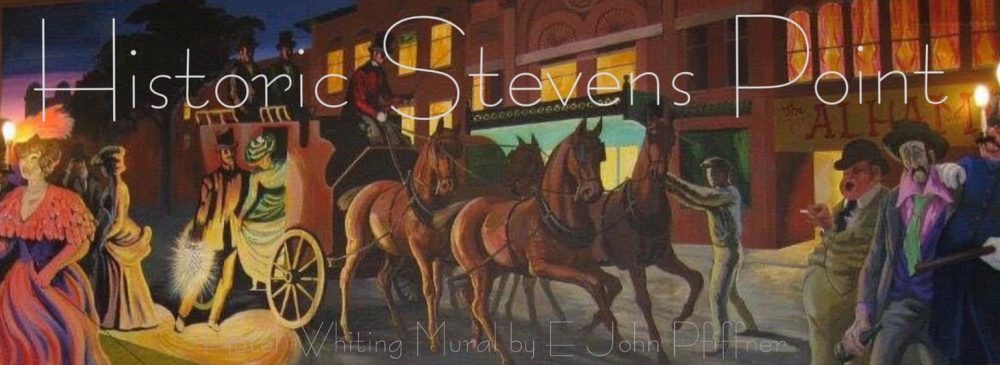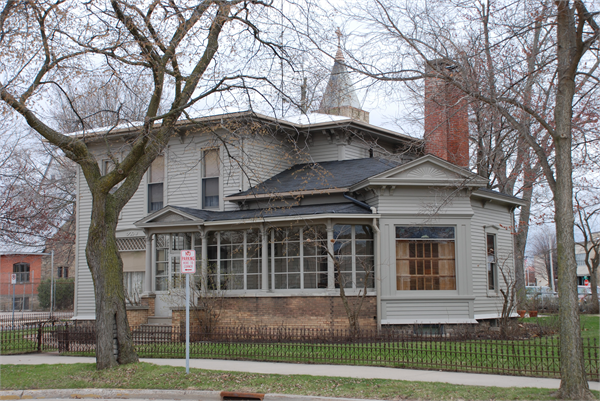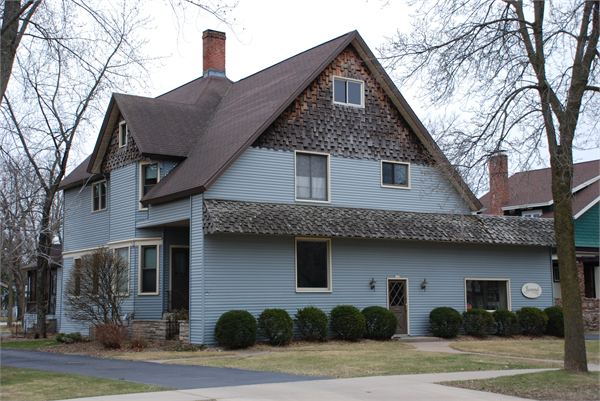‘The more decrepit I look, the more you’ll love me, as this reminds you that I’ll be gone before you.’ – Don Paterson’s summation in Reading Shakespeare’s Sonnet

On the afternoon of February 20, 2022, Historic Stevens Point held a funeral and memorial service in honor of the soon to be demolished historic Gothic Renaissance church building at the corner of Strongs Avenue and Brawley Street near downtown Stevens Point. About 60 people gathered for a short service held on the steps of the building which included a eulogy written and read by our founder, Chelsey Pfiffner, and blessing from the current pastor of Trinity Lutheran Church, as well as beautiful renditions of Amazing Grace and Taps played on trumpet by members of The Grenadiers. The service was immediately followed by a funeral procession in the style of a New Orleans Jazz second line procession complete with prerecorded amplified music, walking a route down Brawley towards Water, and then Clark Streets, leading to the Rose House Venue, where a reception was held with presentations from speakers John Harry, Executive Director of the Portage County Historical Society and Pastor Clay Schmidt from Trinity Lutheran Church, as well as remarks from Pfiffner.
Special thanks to Betsy Heimlich and Ken Camlek of The Grenadiers, The Rose House LLC, Zest Bakery and Coffee House, The Opera House, Trinity Lutheran Church, CREATE Portage County, The Portage County Historical Society, and The City of Stevens Point. And extra special thanks to Nerissa Nelson.
Broadcasts recorded live along with photos of the event and a timeline of the building history will be posted separately.

Eulogy for 1700 Strongs Avenue
By Chelsey Pfiffner
The longer I live, the more beautiful life becomes. If you foolishly ignore beauty, you will soon find yourself without it. Your life will be impoverished. But if you invest in beauty, it will remain with you all the days of your life. – Frank Lloyd Wright
Architect Norman Foster said that “As an architect you design for the present, with an awareness of the past, for a future which is essentially unknown.” We can only imagine if the 19th century architect, JH Jeffers, felt the same, and wonder if he would have ever expected that this would be the fate of his creation.
Trinity Lutheran Evangelical Church… Church of Christ… Turning Point Dance Academy… Dance Dynamics… Home.
She went by many names, but no matter her name, her space gave everyone that knew her… comfort and a sense of belonging.
Born in 1898 of stone, lumber, colored glass, sweat, and steel (to accentuate her inner beauty) she soon became the jewel of the neighborhood.
Beloved by so very many, she has graced us with her glory for almost 125 years, her ceaseless commitment to the very community that loved and adored her never truly going unnoticed.
Knowing both English and Norwegian, our dear gentlewoman, as many with immigrant heritage did, sometimes struggled with her identity and place in the community. She changed her name several times over the years, never quite comfortable with her choice. By 1905 she had started writing solely in English and by 1913 she stopped speaking Norse altogether.
Our lady survived the infamous cyclone of 1908, while others around her were not so lucky. The terrifying incident destroyed the lives of many, but she came out strong unscathed, standing tall, ready to wrap her love around her community and those who needed her most.
Over the years while she was known as Trinity, she over saw numerous weddings, baptisms, and confirmations, she became like family to so very many. A sister, mother, friend… on some of the most important day of their lives.
Change came to her in the form of worship when she became part of the Church of Christ during the 50s, but the 1960s, as for many, gave her a new outlook on life, and by the end of the decade she was ready to make another identity shift, settling down and making space and time for family.
She made new close friends in those years like the The Glodowskis and The Starks. Delighted, she watched their daughters dance and play in the space and light she provided through her inner beauty.
Architect, Louis Kahn once said, “The Sun does not realize how wonderful it is until after a room is made.”
Life began anew in the late 80s when love came to her doors in the form of dance. She was given new color, new life, new love, and with delight, she once again watched on as, this time, 100s of local children, over the span of 25 years, learned to love dance and music while surrounded by her love and beauty.
When the children moved on, and the love eventually followed them, our gentle lady was for the first time, left alone. All alone. As more time passed, the years began to weigh on her, and the loneliness set in, she quietly began to slip into desperation in hopes that she would be noticed, that someone might save her, but in the end her space in the community was forgotten, and her future overlooked.
Today we give gratitude to our old friend, today we let her know there are plenty who did not forget her space in the community, in history, or her place in our hearts.
“Great buildings that move the spirit have always been rare. In every case they are unique, poetic, products of the heart.” Arthur Erickson
She will take a piece of our hearts with her when she goes, but know, that she will live on in our memories forever more.
“That time of year thou mayst in me behold,
When yellow leaves, or none, or few, do hangs,
Upon those boughs which shake against the cold,
Bare ruined choirs, where late the sweet birds sang.
In me thou see’st the twilight of such day
As after sunset fadeth in the west;
Which by and by black night doth take away,
Death’s second self, that seals up all in rest”
-Shakespeare
Thank you to Louis Molepske Jr. for use of the header photo.







